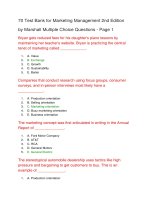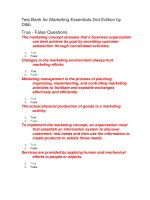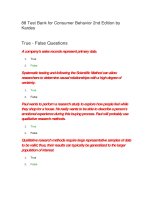Test bank for statistics and data analysis for nursing research 2nd edition by polit
Bạn đang xem bản rút gọn của tài liệu. Xem và tải ngay bản đầy đủ của tài liệu tại đây (102.77 KB, 4 trang )
Full download Test bank for Test Bank for Statistics and
Data Analysis for Nursing Research 2nd edition by Polit
/>Download Solution manual for Statistics and Data Analysis
for Nursing Research 2nd edition by Polit
/>TEST BANK SAMPLE:
Chapter 2
Frequency Distributions: Tabulating and Displaying Data
2.1. A major purpose of constructing a frequency distribution with sample data is to:
a. Estimate a population parameter
b. Test a research hypothesis
*c. Get an organized view of an entire set of scores
d. Get experience with statistical software
2.2. In a frequency distribution, the two key informational components are:
*a. Score values (X), frequencies (f)
b. A horizontal (X) axis, a vertical (Y) axis
c. Frequencies (f), percentages (%)
d. Participant ID number (id), score values (X)
2.3. In a frequency distribution, which of the following is true?
a. Σ N = %
b. Σ N = f
c. Σ f = %
*d. Σ f = N
2.4. In the equation Σ % = 100.0, the symbol Σ signifies:
a. A percentage
*b. The sum of
c. A data value
d. A frequency
2.5. In a frequency distribution, percentages are sometimes called:
a. Proportions
b. Relative proportions
*c. Relative frequencies
d. Cumulative proportions
2.6. Data for which of the following variables is most likely to be presented in a grouped
frequency distribution?
a. Nursing specialty area
*b. Daily cholesterol intake
c. Number of abortions
d. Number of pets owned
2.7. The level of measurement for data appropriately presented in a bar graph is:
a. Interval or ratio
b. Nominal only
c. Interval only
*d. Nominal or ordinal
2.8. In a frequency distribution graph, frequencies are typically presented on the ____ and data
values are presented on the ____________. (Fill in the blanks.)
*a. Y axis, X axis
b. X axis, Y axis
c. f axis, N axis
d. N axis, f axis
2.9. Which of the following sets of data is not unimodal?
*a. 1, 1, 1, 2, 2, 2, 2, 2, 2, 2, 2, 3, 3, 4, 5, 5, 5, 5, 5, 5, 5, 5
b. 0, 0, 0, 0, 0, 0, 0, 0, 1, 1, 1, 2, 2, 2, 2, 3, 3, 3, 4, 4, 4, 4
c. 0, 0, 1, 1, 1, 1, 1, 1, 1, 1, 1, 1, 1, 1, 1, 1, 2, 2, 3, 3, 4, 5
d. 1, 1, 2, 2, 3, 3, 4, 4, 5, 5, 5, 5, 5, 6, 6, 7, 7, 8, 8, 9, 9
2.10. Which of the following variables is most likely to be negatively skewed in a general
population?
a. Number of times arrested
*b. Age at retirement
c. Number of times married
d. Age at birth
2.11. A normal distribution is not:
a. Skewed
b. Leptokurtic
c. Platykurtic
*d. All of the above
2.12. A wild code is:
*a. A value that is impossible given the coding scheme
b. An outlier or high value
c. A code for which there is a very low frequency
d. A code for which there is a very high frequency
The next eight questions pertain to the following table (Table 2):
Table 2
Frequency
Percentage
Number of
Cumulative
Pregnancies of Study
Percentage
Participants
0
24
11.1
11.1
1
29
13.5
24.6
2
78
36.3
60.9
3
46
21.4
82.3
4
22
10.2
92.5
5
11
5.1
97.6
6
4
1.9
99.5
7
1
0.4
100.0
Total
215
100.0
2.13 In Table 2, the variable is _______ and the measurement level is _________. (Fill in the
blanks.)
a. Discrete, interval
*b. Discrete, ratio
c. Continuous, interval
d. Continuous, ratio
2.14. Table 2 is an example of a:
*a. Frequency distribution
b. Grouped frequency distribution
c. Class interval
d. Data matrix
2.15. In Table 2, the value of N is:
a. 24
b. 100.0
*c. 215
d. 7
2.16. In Table 2, the cumulative relative frequency for five or fewer pregnancies is:
a. 210
b. 199
c. 92.5
*d. 97.6
2.17. The best way to graph information in Table 2 would be to construct:
*a. A histogram
b. A pie chart
c. A bar graph
d. Either a pie chart or a bar graph
2.18. In Table 2, the distribution of data would be described as:
a. Symmetric
*b. Positively skewed
c. Negatively skewed
d. It cannot be determined.
2.19. In Table 2, the distribution of data would be described as:
*a. Unimodal
b. Bimodal
c. Multimodal
d. It cannot be determined.
2.20. In Table 2, the most likely number to be an outlier is:
a. 0
b. 1
*c. 7









